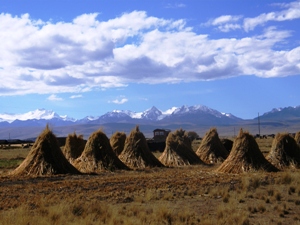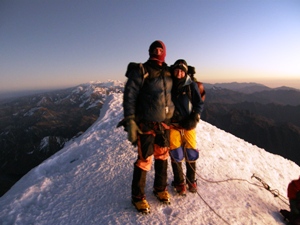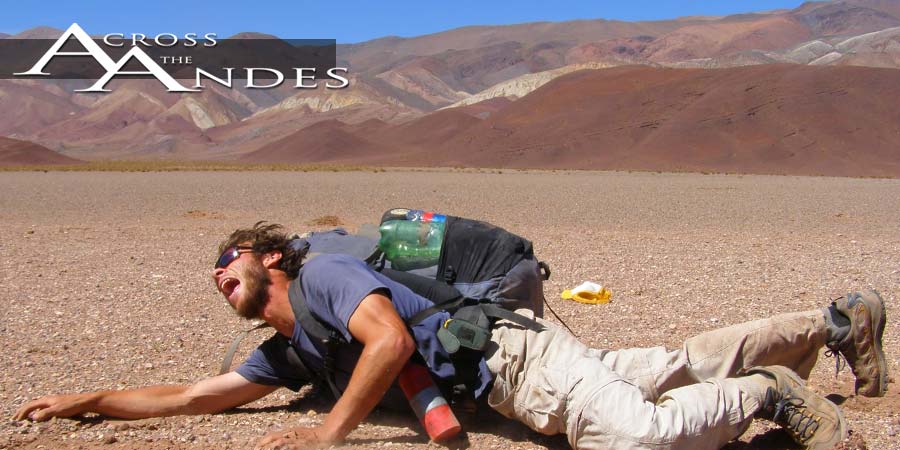Origin of Man
By Gregg Treinish
June 26, 2007

Leaving Oruro, we were falling a bit behind schedule. With more than 160 miles left to hike to the border, we were assuming that we’d need somewhere in the neighborhood of 10 days to reach Lake Titicaca, something that we have been looking forward to for more than a while. On the first day out of town, we set a trend that would last us throughout the week. Hiking well into the night, covering 25 miles a day was not as difficult as one might think. We’d make the border, our halfway mark, and the waters of Lake Titicaca in just six long days.
As we have said many times before, walking on the flat altiplano is less than exciting and probably some of the hardest hiking that we have encountered yet. It was three days out of town that we became far too fed up with the staticness, and made a b-line straight for the nearest mountains that we could see. It was a gamble seeing as we had no maps, but with our mental wellness at stake, the choice really made itself. Almost immediately as we returned home, things were better. People began showing interest in us again, there was a period of about five hours on that first day where it was extremely difficult to walk, not because of the terrain, but rather because every single household would stop us to ask about our trip. Deia commented at some point that we were yet to have a Bolivian homestay, something that seemed odd to both of us as Bolivians are amongst the kindest people we have come across yet. Not more than ten miles later, having arrived in a small town, Christina, a woman who owns the only store in town, insisted that we stay in her house. The very next evening, as we were getting ready to again push well into the night, Alfredo invited us to spend the night with his family. Whereas Christina’s house simply offered us a place to stay, the experience with Alfredo’s family was one that neither of us will be forgetting for a long time to come. Instantly upon our arrival we were welcomed, not only by Alfredo’s parents, but by his sisters, cousins, nephews, and nieces. We were invited inside and though we had asked only to use the stove so that we might cook our usual noodles and soup packets, we’d eat well into the night, being treated as if we, too, were part of the family reunion that brought relatives from far and wide. Thirteen of us would fill the one main room of the mud brick house. We laughed that night perhaps more than with any family to date as we shared stories about our hike and they told us about the Aymaran way of life. After every course including the tea, the children would get up and thank everyone in the room, both for their company and the food. The adults would follow, for ten minutes we would exchange kisses, hugs, and thankyous (always responded to with an “enjoy”). A sheepskin bed was prepared for us on the floor and we’d make the most of the very few hours of the day that this family uses to sleep, to recover from the day’s hike. By 5:30 a.m. we were up, eating our first breakfast, and getting ready to continue hiking. It was just after the sun rose at 7a.m. that I was brought outside to help prepare a sheep for the day. We selected the sheep from the pen, the machos are always most rico, and by 8:30 his ribs were on the fire and his oysters boiling in the soup. By ten in the morning this family, working all together, had accomplished more than I had ever seen accomplished in an entire day. The burros were prepared to go to town, the cows milked, the house swept, the sheep turned to meat, and goodbyes said. We walked to town with a few of the family members and continued on over the next hillside to see what we would see. Throughout the following days we would cross farmland, watching as the people of the Aymaran tribe harvested their potatoes and wheat for the season. We were often stopped along the way and given directions and wishes of happy travels, all the while welcomed as if we had returned home, I still love Bolivia.

More quickly than either of us could have imagined, we found
ourselves walking alongside the monsters that make up the Cordillera
Real. Illimani, Huyana Potosi, Illampu, Condorini group, although these
names probably don’t mean that much to all of you, for us it meant not
only the fact that we had reached a place that for so long had seemed
like a far-off dream, that we had reached one of the greatest spots in
the Andes, and more importantly HALF WAY! As we approached the shores
of Lake Titicaca, the significance of what we had achieved definitely
hadn’t yet sunk in. As we cracked out the first two beers in the plaza
of Batallas, Bolivia, the awareness came; the shouts were not far
behind. I wonder if there is one person in Batallas who did not see us,
stare at us, and wonder what the hell was so great about reaching the
center of their town. I doubt that anyone has ever been that excited
before to get to the tiny forgotten town of Batallas.
A major reason that we had pushed as hard as we did, was to give
ourselves the opportunity to climb another peak. Huyana Potosi is 6088
meters or 19974 feet, and one of the most incredible peaks that I have
ever seen. Though it was entirely disappointing to fall 26 feet short
of 20,000, I can only say that the peak was far beyond my expectations.
With perfect weather ( -10 degrees or so on the summit), and with both
of us actually healthy for this climb, we started up just after 2 a.m.
as the snow is too soft during the day. We climbed for nearly five
hours crossing narrow ridgelines and skirting between bottemless
crevasses all obsured on the way up by a moonless night. After
finishing the climb with a 300 ft. wall steeper than anything I have
ever been on, we had done it, we had reached the summit and we embraced
one another on the top. The summit itself was outrageously narrow,
maybe six feet at best, with a drop off the back side of well over 4000
ft., which helped contribute to my inablity to hold back my tears. I
was enveloped with emotion, alternating between screaming and shivering
from the bitter temperatures. The climb had been easier than I had
anticipated, perhaps a symptom of the shape we are in, but was an
incredible challenge none the less. We watched the sun rise from the
summit and could stand the cold no more. We have come so far, and been
through so much on this trip, it is hard to say something like it was
one of the greatest accomplishments thus far, but man am I proud of us!
After celebrating for a few days in La Paz, a city that has a much
worse reputation than it deserves, we decided that we were much too
close to the range not to trek in it. Despite the fact that it was
southeast, directly the opposite way of where we have been hiking, we
broke for it. Warnings soon came from seemingly everywhere that we
needed guides, that surely we’d get lost never to be seen again. It was
entirely too difficult for anyone to understand that we have been
walking for an entire year now, that we have covered almost 4000 miles,
and that we have indeed had some experience hiking in the mountains
before. On the first day, we got lost. As the clouds rolled in, and the
temperature dropped, we soon realized that we were no longer on the
trail, that we had taken a wrong turn and could only guess exactly
where we were. It is lucky for us that the peaks around were well over
20,000 ft., so with some careful triangulation, and entirely ridiculous
climbing, we were back on track and once again cruising through some of
the most incredible scenery that either of us have ever been in. We
made it three days, jaws dropping at every pass, hands and toes
freezing every morning, until we could hike no more. Descending from a
ridge, entirely excited and ready to climb the one that was to follow,
the soles of my shoes decided that they no longer wanted to hike, and
completely disintegrated. I get upset just thinking about the fact that
we had to leave that place early, there is nothing worse than not
finishing a hike, even if it is only an extra side section of a 7500
mile journey. For those of you who don’t know, South Americans are
short, well at least in the north they are. They don’t have big feet,
shoes above size 11 don’t exist. I wear a 13. It is hard, really hard,
to find shoes down here. It was about the luckiest thing in the world
that there was a fair in La Paz the day after we got back and that
there was a section of the fair called used American clothing. I just
hope this pair of shoes lasts until Cusco.

With our window of opportunity to reach Queropalca, Peru, where we left off in the north, running out, we were unable to return to the range, and instead continued on to the orgin of man and the Island of the Sun on Lake Titicaca. I can’t say that name enough. Lake Titicaca along with Lago Popoo, the one we crossed further south, is only a tiny puddle of what was once a giant lake that went from Ecuador to the middle of Argentina, but you still cannot see land on the other side. It is more than 150 miles long and incredibly beautiful. The books describe it as the Mediterranean of South America with the added bonus of 20,000 ft peaks rising from its shores. White sand beaches and labyrinth ruins bring thousands of tourists every year. It really is an incredible place, but isn’t the mountains. The entire time we were on the lake, I was anxious to get back to the hike, to the mountains, to what I love. We did meet some awesome people, and did have a great time invading the Bolivian Navy in paddle boats (not peddle boats), so all was not a bust. As we sit tonight, still on the shores of the highest navigable lake in the world (whatever that means), I must go hiking, I must walk. I am never as happy as I am when we are walking, and after a long 14 day break from making progress towards our ultimate goal, I cannot wait any longer, I will not wait any longer. So once again without maps, tomorrow we begin hiking north in Peru. I will miss Bolivia, as it currently holds the title of my favorite country, and both of us agree that yesterday was not the last that we spend there. I just spent an hour or so looking at Google Earth to see which route we should take towards Cusco and Machu Pichu and I was incredibly happy to find that the upcoming month should be every bit as exciting as the last was. With only two months to go to link our Northern trek with this one, I am incredibly exicted, incredibly anxious, and begining to allow myself to be proud of what we have done, and are doing down here. I have been missing people a lot lately, and am excited that we will be taking a brief trip home before returning to do the last section though Patagonia. Please write, please let me know how all of you are.







